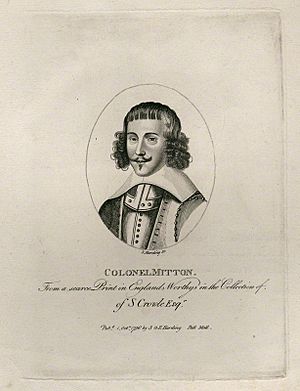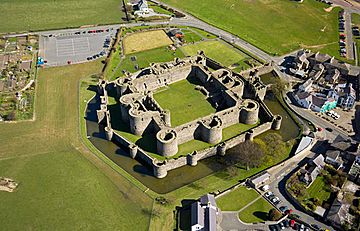Thomas Mytton facts for kids
Quick facts for kids
Thomas Mytton
|
|
|---|---|

Thomas Mytton, 1796 engraving of original portrait
|
|
| Member of Parliament for Shropshire |
|
| In office September 1654 – January 1655 |
|
| Vice-admiral, North Wales | |
| In office 1647–1649 |
|
| High Sheriff of Shropshire | |
| In office 1644–1645 |
|
| Personal details | |
| Born | 1597 Halston, Shropshire |
| Died | 29 November 1656 (aged 59) London |
| Resting place | Old St Chad's Church, Shrewsbury |
| Political party | Parliamentarian |
| Spouses | (1) Magdalen Napier (1629-1648) (2) Barbara Leonard (1649-his death) |
| Children | Margaret (1626-1647), Richard (1637-1670), Mary (?) and Sarah (1638-1698) |
| Alma mater | Balliol College, Oxford |
| Occupation | Lawyer, soldier and administrator |
| Military service | |
| Allegiance | |
| Years of service | 1642 to 1648 |
| Rank | Major General |
| Battles/wars | Wars of the Three Kingdoms Oswestry; Montgomery Castle; Denbigh Green; North Wales campaign 1646; Battle of Red Hill 1648 |
Thomas Mytton (1597-1656) was an important figure during the English Civil War. He was a lawyer from Oswestry, England. Thomas Mytton became a Major General in the Parliamentarian army.
The Parliamentarians were also called the Roundheads. They fought against King Charles I's supporters, known as the Royalists. This conflict was part of the Wars of the Three Kingdoms. Mytton also served as a Member of Parliament (MP) for Shropshire.
Mytton came from a well-known local family. Most wealthy families in Shropshire supported the King. However, Mytton chose to support Parliament. He became a skilled military leader. He eventually led Parliament's forces in North Wales. In 1647, he was also made Vice-admiral of North Wales.
After the war, Mytton stopped his military work. He became an MP in 1654. He passed away in London in November 1656. He was buried in St Chad's Church, Shrewsbury.
Contents
Thomas Mytton's Early Life
Thomas Mytton was born in 1597. He was the only son of Richard Mytton and Margaret Owen. His family lived at Halston Hall in Shropshire. His mother's father, Thomas Owen, was a judge.
Thomas Mytton had a sister named Sarah. She married Sir Edward Acton. Sir Edward was an MP for Bridgnorth.
In 1629, Mytton married Magdalen Napier. They had several children. These included Margaret, Mary, Richard, and Sarah. After Magdalen passed away in 1648, Mytton married Barbara Lennard in 1649. They did not have any children.
Education and Early Career
Thomas Mytton went to Shrewsbury School. After that, he studied at Balliol College, Oxford in 1615. He then trained to be a lawyer at Lincoln's Inn in 1616.
We don't know much about his life before the war. However, he supported Parliament. This was unusual because most wealthy families in Shropshire were Royalists. Both his mother's and first wife's families supported the Puritans. Puritans were a group who disagreed with King Charles I's policies.
Role in the Civil War
The First English Civil War began in 1642. The town of Shrewsbury was important for the Royalists. They gathered soldiers and supplies there. In 1643, Parliament appointed military leaders for the region.
Mytton formed a group of soldiers in Cheshire. He joined Sir Thomas Myddelton to capture Wem in September 1643. Wem became the first Parliamentarian base in Shropshire. Mytton used Wem to support campaigns against Royalist areas.
In June 1644, Mytton and the Earl of Denbigh captured Oswestry. This cut off Shrewsbury from Chester. It also opened a path for Parliamentarian attacks into Wales. Mytton and Myddelton then captured Montgomery Castle in September. A Royalist attempt to take it back failed. This was a major victory for Parliament.
Mytton captured Shrewsbury on February 22, 1645. This forced the Royalists to leave central Shropshire. The war was becoming very harsh. Mytton was promoted to Major General in April 1645. He became commander in North Wales. He was also made High Sheriff of Shropshire.
By late 1645, the Royalists were losing badly. Mytton defeated a Royalist force at Denbigh Green. This helped Parliament capture Chester in February 1646. Mytton then worked to take over Royalist strongholds in North Wales. These places could have been used by Royalist supporters from Ireland.
On June 10, King Charles told his remaining forces to surrender. Most of them did not listen. By August, Mytton had captured Ruthin, Caernarfon, and Beaumaris on Anglesey. Denbigh Castle surrendered in October. Conwy held out until November. Harlech was the last to fall in March 1647.
After the War

After the war, there were disagreements in Parliament. The soldiers in Wales had not been paid for 18 months. The main army, the New Model Army, was owed a huge amount of money. Parliament ordered the New Model Army to go to Ireland. But the soldiers demanded full payment first. The army was then disbanded in April 1647.
Mytton's soldiers were not part of the New Model Army. So, he kept his position. In December, he became Vice-admiral of North Wales. He also received money from Royalist lands.
The Second English Civil War started in April 1648. Some Parliamentarian soldiers in South Wales rebelled because they weren't paid. But Mytton remained loyal. The rebellion in the south was quickly stopped. In the north, Mytton and Myddelton defeated a Royalist force at Red Hill. They also recaptured Beaumaris Castle in October.
This was the end of Mytton's military career. He played a smaller role during the time without a king, called the Interregnum. He was part of the court that sentenced the Earl of Derby to death. The Earl had been involved in the Third English Civil War in 1651. Thomas Mytton represented Shropshire in the First Protectorate Parliament. He passed away in London in November 1656. He was buried on November 29 in the original St Chad's Church, Shrewsbury.
Images for kids
-
Beaumaris Castle; captured by Mytton in June 1646 and October 1648


